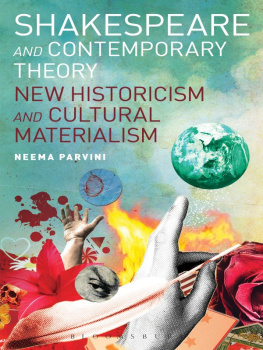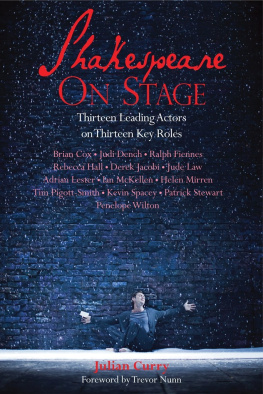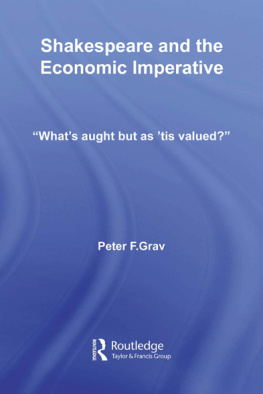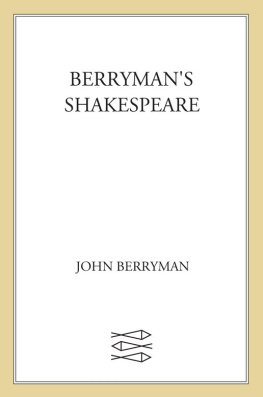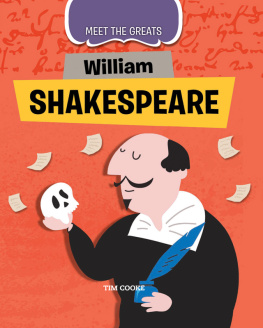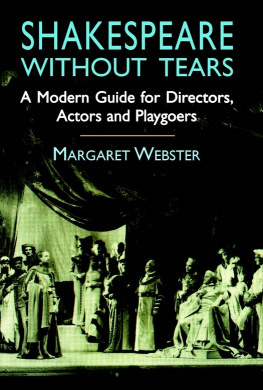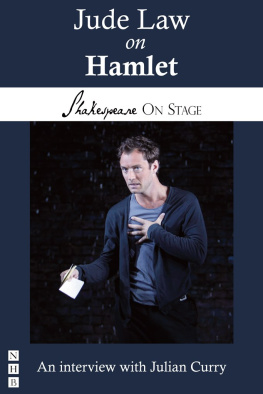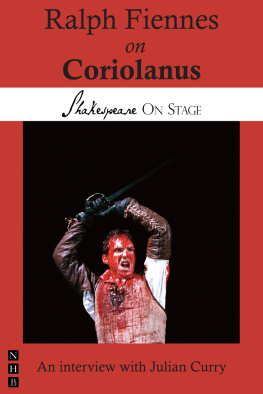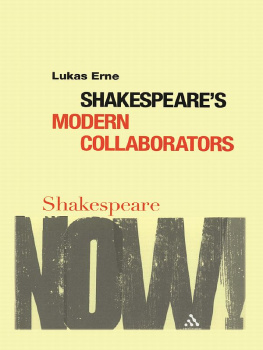SHAKESPEARE IN PARTS
SHAKESPEARE IN PARTS
SIMON PALFREY AND TIFFANY STERN


Great Clarendon Street, Oxford OX2 6DP
Oxford University Press is a department of the University of Oxford.
It furthers the Universitys objective of excellence in research, scholarship,
and education by publishing worldwide in
Oxford New York
Auckland Cape Town Dar es Salaam Hong Kong Karachi
Kuala Lumpur Madrid Melbourne Mexico City Nairobi
New Delhi Shanghai Taipei Toronto
With offices in
Argentina Austria Brazil Chile Czech Republic France Greece
Guatemala Hungary Italy Japan Poland Portugal Singapore
South Korea Switzerland Thailand Turkey Ukraine Vietnam
Oxford is a registered trade mark of Oxford University Press
in the UK and in certain other countries
Published in the United States
by Oxford University Press Inc., New York
Simon Palfrey and Tiffany Stern 2007
The moral rights of the authors have been asserted
Database right Oxford University Press (maker)
First published 2007
All rights reserved. No part of this publication may be reproduced,
stored in a retrieval system, or transmitted, in any form or by any means,
without the prior permission in writing of Oxford University Press,
or as expressly permitted by law, or under terms agreed with the appropriate
reprographics rights organization. Enquiries concerning reproduction
outside the scope of the above should be sent to the Rights Department,
Oxford University Press, at the address above
You must not circulate this book in any other binding or cover
and you must impose the same condition on any acquirer
British Library Cataloguing in Publication Data
Data available
Library of Congress Cataloging in Publication Data
Data available
Typeset by Laserwords Private Limited, Chennai, India
Printed in Great Britain
on acid-free paper by
Biddles Ltd., Kings Lynn, Norfolk
ISBN 9780199272051
1 3 5 7 9 10 8 6 4 2
To the memory of Eileen Palfrey (19301999)
and Geoffrey Stern (19352005)
Preface and Acknowledgements
This book emerged out of a friendship. We each knew the others first book, one on early modern rehearsal, the other on Shakespeares late plays. Stern was particularly engaged with the practices of the theatre and with the fragmentary nature of its texts, Palfrey with the peculiar ways in which minds and moments are animated in and by dramatic language. We wondered whether two such different approaches might gel in interesting and even unprecedented ways. So we met and laid out our wares. Im thinking about actors parts, but I dont know where to start, said Stern; Im thinking about the vertiginous dramatic moment, and I dont know where to stop, said Palfrey. This book is the result.
Readers may be curious as to who did what. We thought of saying that Stern gave the cues and Palfrey the speeches, but the fact is that it has been a dialogue throughout. Both of us have read, edited, and reread even those parts that we did not initially write. Whether we have produced something larger than the sum of our respective parts is for others to judge. What we know for sure is the debt each of us owes the other. Neither of us could have written it, or even thought of it, alone.
But obviously we owe thanks to many others. We would like to acknowledge the generosity of the AHRB, which awarded us an Innovations grant, without which this work would never have taken shape. We are grateful, too, to both our then institutionsOxford Brookes (Tiffany) and Liverpool University (Simon)for letting us take up the opportunity that the grant gave us, and to our new institution, Oxford University, for providing us with jobs so near to each other and to the Bodleian Library.
We have given papers based on sections of this book at the Shakespeare Association of America and the World Shakespeare Congress: we thank the British Academy for funding travel, and our fellow seminarians for their trenchant comments. Papers based on this book have also been given by each of us at Oxford, Cambridge, and Yale: again, we are grateful to listeners for their suggestions and advice. An earlier version of one of our chapters has appeared as What Does the Cued Part Cue? Parts and Cues in Romeo and Juliet, in the Companion to Shakespeare and Performance, edited by Barbara Hodgdon and W. B. Worthen (Oxford: Blackwell Publishing, 2005), and we wish to acknowledge Blackwell Publishing which gave us permission to reprint this piece.
Librarians at the Beinecke Library, the Bodleian Library, the British Library, Cambridge University Library, Harvard Theatre Library, the Houghton Library, and the Huntington Library have all been unfailingly generous of their time; librarians at the Folger Shakespeare Library deserve special mention. The several illustrations in this book are reprinted by kind permission from the Governors of Dulwich College, the Folger Shakespeare Library, and the Houghton Library. Thanks also to MOMA (New York), La Scala, and the Giorgio de Chirico estate for permission to use his picture, Le Duo (Les Mannequins de la tour rose), as our cover image.
The artful words of David Scott Kastan and Gordon McMullan were instrumental in helping us get the funds to begin this piece. At OUP Sophie Goldsworthy and Andrew McNeillie have been supportive commissioning editors, and Tom Perridge a patient and understanding editor. Latterly Jacqueline Baker and Jean van Altena have helped see the book through to completion. We also very much benefited from the learning and expertise of three anonymous OUP readers. Our thanks to all of them: their suggestions helped make this a better book.
During the writing of Shakespeare in Parts we have both had numerous stimulating conversations with friends, colleagues, and passing acquaintances. Together we had a list of more than a hundred such creditors, so many as to make mention of them fairly meaningless and (accidental) omission doubly insulting. So a blanket thanks to all. Nonetheless, Simon would like to give particular praise to Jo, who is delighted the project is over, and to Georgia, Ella, and Louis, who barely knew it had begun; and Tiffany would like to praise her equally forgiving family, Jonty Stern, Elisabeth Stern, Joy Moore, andthe inspiration for so much that is herePatrick Tucker.
Contents
List of Illustrations
1. The part of Orlando from Robert Greenes Orlando Furioso(1590s). By permission of the Governors of Dulwich College.
2. The part of Trico from Ferdinando Parkhursts Ignoramus (16624). By permission of the Houghton Library, Harvard University.
3. The part of Sir Archy from Charles Macklins Love la Mode (c. 1760). By permission of the Houghton Library, Harvard Theatre Collection, Harvard University.
4. The part of Shylock from William Shakespeares Merchant of Venice (1772). By permission of the Folger Shakespeare Library.
Textual Notes
First Folio quotations are taken throughout from the facsimile prepared by Charlton Hinman, Mr. William Shakespeares Comedies, Histories, and Tragedies [The Norton Facsimile](New York: Norton, 1968), using the through-line-numbers (TLN) of that edition. Folio speech-prefixes, however, have been expanded and, where necessary, modernized or regularized for ease of reference. Quotations from Quarto texts are from the facsimiles prepared by Michael J. B. Allen and Kenneth Muir,
Next page


